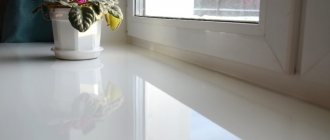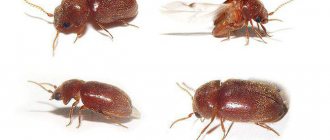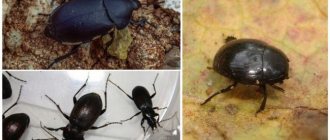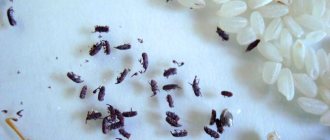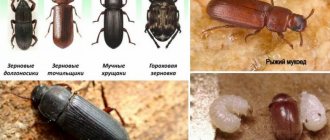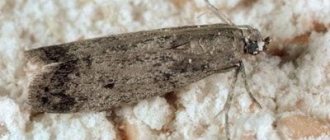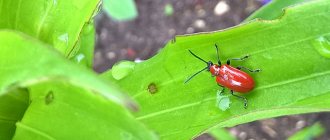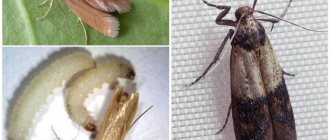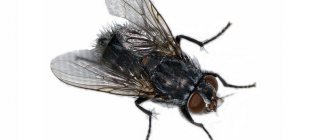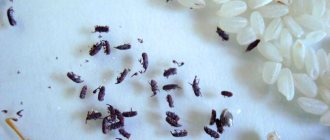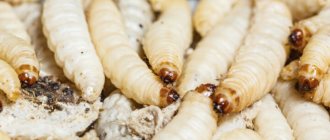In the spring, many Russian residents are faced with the appearance of small bugs on the windowsill. They come in different types and fly into the light from the window. If there are a lot of bugs, most likely there is a nest with larvae in the house. The resource “VredStop.ru” has collected information about the most common pests that fit the description “brown and black little bugs.”
Brown bugs on the windowsill - what are they called?
When we talk about “small” bugs, we most often mean bugs the size of a match head, or even smaller. Several hundred pests fit this description. But in houses and apartments, 2 types are most often found:
- Carpet beetle.
- Grinder.
It is believed that the first one starts due to dust, a large number of old things in the house, carpets, and the second one feeds on flour and cereals. They end up on the windowsill, like many other insects, by flying into the light. In the evening, the bugs move into the ceiling lamps, where they often die.
Carpet beetle
The pest is very common in private homes, but can also live in apartments. He was nicknamed the Kozheeder for his passion for leather goods, and in particular, for museum stuffed animals. He is not interested in human skin. In general, the bug is almost omnivorous. He eagerly eats bread crumbs, nuts, fur products, carpets, books, and wood. There are known cases where skin beetles have gnawed through plastic, asbestos, the walls of buildings, eaten stocks of beans, grain, meat, dried mushrooms and spices, and damaged agricultural vehicles.
You can recognize the skin beetle by its characteristic hard oval back. In appearance it looks like a ladybug, only dark brown or black, and very small. The length of the body does not exceed 3 mm, and a tail-tassel is visible at the tip. If you look at the bug through a magnifying glass, you will notice tiny hairs on the back.
Skin beetles have rather large and mobile larvae, about 2 mm in size. They hide mainly in dry, warm and dark corners, in accumulations of dust. A new individual hatches, on average, after 2 months. But beetle eggs in favorable conditions can survive up to 5 years.
Photo of the skin beetle:
Another notable feature of the skin beetle is its manner of movement. They prefer to slowly crawl, and at any touch they instantly roll over with their belly up, as if dead. Skin beetles can also fly, and if you crash into a person, the collision is very noticeable due to the rigidity of the bug.
Kinds
There are about 700 varieties of skin beetles. In nature, these insects process dust, feathers, wool and bones of dead birds and animals. In the absence of a natural source of food, 7 species of skin beetles live in apartments and houses:
- Ham. Well recognizable due to its characteristic color. The beetle is oblong, with a black head and lower elytra. A light gray stripe with black dots runs across the back. Body length can reach 7-8 mm. The bug prefers food of animal origin (meat and bone meal); it can eat leather and fur products, and cereals. Photo of ham skin beetle:
- Brownie. A small motley bug measuring 2-3 mm damages wool, felt, and less often meat products. Its back is covered with light gray and brown spots. Photo of the house beetle:
- Museum. In appearance and color it is similar to the house leather beetle, but is much darker. It is a dangerous pest of museum exhibits. In apartments and houses it feeds mainly on dead insects, the remains of egg capsules, cocoons, etc. What does a museum leather beetle look like:
- Carpet. It is distinguished by its coal-black color, but its antennae and paws are black. The carpet beetle is an omnivore, but prefers to feast on products made of wool and down: carpets, pillows, blankets, coats. Photo of the bug and larva:
- Fur coat. Capable of quickly destroying products made from natural wool and down. It differs from the carpet beetle in its elongated body shape and the presence of 3 small white spots on the back. The color of the bug is brown-black, the back looks like velvet. Photo:
- Grain. It eats grain and often affects warehouses where it is stored. Can destroy up to 70% of stocks in a few months. The bug has a light brown color, reddish hairs, legs and antennae. This is what it looks like:
- Kozheed Smirnova. The most common species in Russia. Smirnov's Kozheed has adapted almost as well to life near humans as cockroaches. It is omnivorous, the larvae eat the felt backing of linoleum, pet hair, dust, and food. Adults do not feed, but live off the reserves accumulated during the larval stage. The bug is brown in color. Photos close up:
Grinder
The borer beetle in nature settles in decaying wood - in stumps, dying trees, etc. The length of the insect's body ranges from 5 mm to 1-1.5 cm. The larvae of the borer are white or white-yellow, large, curved, shaped like a letter "WITH". They have well-developed legs with claws and a large head with reddish pubescence.
The grinder beetle is popularly known as the “death clock.” Moving through holes in the wood, it makes a characteristic sound. People have noticed that after the “ticking” appears, the house collapses within several years. The bug is predominantly nocturnal.
Over the years, grinders have learned to coexist with humans, and their diet has become more varied. Some bugs “specialize” in cereals, others in wallpaper glue, books, garbage, furniture, etc. Grinders are active from May to October. Photo:
Kinds
There are about 1,500 subspecies of grinders, but in the house on the windowsill you can most often find:
- Bread grinder. The bug, 1.5-4 mm in size, is brown in color and eats mainly cereals, cookies, pasta, flour, dried fruits, confectionery and spices. Grinders themselves are rarely found in products. Their milky-white oval eggs and larvae, which resemble thick worms, live there. Photo:
- Furniture sharpener. It parasitizes dry wood of any species. Gnawing holes in floors, windows, walls. The color of the bug is brown, on the back there are stripes that consist of many dots. Photo:
How to get rid of them?
Whatever type of beetles appears in a house or apartment, the first thing you need to do is find nests with larvae. It is pointless to destroy only adult individuals on the windowsill. Very soon new offspring will emerge from the nest, and the number of pests will grow rapidly. The female lays several dozen eggs at a time.
If adult beetles are found on the windowsill, there are larvae and eggs somewhere in the house, and in large quantities.
A step-by-step guide will help you quickly and permanently solve the problem of small bugs in your apartment:
- It is necessary to inspect food supplies, cracks and cracks in window frames, the space behind baseboards, inside furniture, under the carpet, leather and fur clothing, shoes in the shoe rack, and all dark secret corners. It will be easier to detect bug nests if you first determine their type and find out what they eat.
- Bug nests can be numerous and scattered throughout the house. It's important to find them all. They are usually full of eggs and larvae, and are covered in dust from food and objects eaten.
- Remove the larvae. You need to thoroughly wash the surfaces, steam, wash, freeze.
- Treatment with chemicals (insecticides) is carried out whenever possible and is not of primary importance, especially if food or a children's room is contaminated.
- Throw away or quarantine all potentially contaminated food and items. Quarantine means storage in thick polyethylene for 3 months. If during this time no larvae or bugs appear inside, it means that the product (item) was not contaminated.
- Carry out prevention for 6-12 months after detecting bugs on the windowsill.
Store-bought remedies for black and brown bugs, cockroaches and ants
Among such means, suitable ones would be: Mashenka type crayons, electronic traps, chemical powders (Regent), Raptor gel, Dichlorvos, Fumitox, DEET, Taiga.
Follow the rules and precautions. To speed up the process of removing domestic parasites, you can use several methods at once.
Advice. In order to prevent the hatching of larvae, the room must be treated several times in one month.
Let your home avoid such troubles, take care of your nerves and health!
Methods for dealing with small bugs
To destroy bugs in an apartment, various folk and chemical means are used. The use of the latter requires compliance with precautions. Do not treat food or kitchen surfaces with chemicals, or use poisons in a home where there are animals and children.
Methods for dealing with small bugs on the windowsill:
- Treatment with Dichlorvos, Reid, Chlorophos, Raptor sprays. The products kill adults and larvae in seconds. You need to spray them wearing a mask, and after treatment, thoroughly ventilate the room.
- Application of insecticides in the form of suspensions, tablets and traps. They are of little help against adults, but they are good at destroying larvae, which happily absorb the bait. The products are used strictly according to the instructions.
- Freezing. At a temperature of -10-15 degrees, most species of bugs die. Small items can be frozen in the freezer, and the carpet can be taken outside in the cold. You can also get rid of bugs in a country house or in a house without centralized heating using the freezing method. The minimum time of exposure to cold is one day.
- Boiling. It will help get rid of bugs, larvae and eggs in bedding, upholstery, soft toys, and clothes. It is necessary to soak things for 30 minutes in hot water 60 degrees, boil in a saucepan for 2-5 minutes or wash in a washing machine in the “Cotton” mode.
- Steam treatment. Using a steam generator, you can quickly and easily destroy insect nests in cracks of window frames, walls, upholstered furniture, behind baseboards, etc.
- Boric acid (powder). It is necessary to sprinkle the powder on the places where pests and their nests were noticed. If the surface is fleecy, rub in boric acid with a brush. The product must be washed off after a day.
- Laundry soap, vinegar, bleach. Based on them, solutions are prepared that are used to wipe surfaces damaged by pests. Insects do not like the pungent smell, and hastily leave their favorite places.
- Turpentine with kerosene. The products are mixed in a ratio of 3 to 1 and poured into the holes left by the furniture sharpener.
- Gasoline with mothballs. 100 ml of gasoline is mixed with 10 g of naphthalene and the affected wood is treated. The best way to do this is with a brush.
Ants
These insects live in numerous colonies. The colony is divided into separate nests that are interconnected. Destroying one nest will not give any results, as others will remain. Therefore, dealing with house ants is not an easy task. They are also called red or pharaoh ants.
In the morning, the inhabitants of the nest wake up, and 15 percent of the worker ants go hunting. The rest do not leave the nest, servicing the queen and her brood. A queen ant can live up to 15 years.
She lives to such a respectable age thanks to the tireless care of worker ants. If no measures are taken, the colony will grow very quickly and can reach several hundred thousand individuals. The usual size of worker ants is 2 millimeters, the queen can reach 4 millimeters.
House ants are very unpretentious insects and are able to adapt to any conditions. It is very difficult to get rid of the dominance of house ants, so you need to take measures in advance to prevent their appearance: protect the ventilation openings with a special mesh, and draw special insecticidal pencils in front of possible places where insects can enter.
Prevention
After removing small black and brown bugs, you need to remain vigilant. They may appear again. It is very important to prevent pests.
- Increase the frequency of cleaning. If possible, you should vacuum the apartment every day, paying special attention to cleaning upholstered furniture, carpets, the space under and behind radiators, cabinets, and sofas.
- Seal all cracks and crevices where bugs can settle.
- Install screens on the windows to prevent insects from entering the house in the future.
- Throw away trash: broken items, old clothes, stacks of newspapers, cardboard boxes, etc.
- Once a season, wash all the clothes in the closet, and wipe the shelves and internal surfaces with a damp cloth with the addition of White (30-50 ml per 2 liters of water) or vinegar (100 ml per 1 liter of water).
- Store cereals, flour and pasta in glass jars.
- Every 1-3 months, carry out general cleaning of kitchen cabinets and shoe racks with disinfection of internal surfaces.
Where do black and brown bugs, as well as cockroaches and ants, come from and why are they dangerous?
It doesn’t matter whether you live in an apartment or a private house, you can find the following parasites in your home:
- black bugs;
- brown bugs;
- cockroaches;
- ants.
Brown bugs
Also among household pests you can find moths, mosquitoes, bedbugs, fleas and other obnoxious creatures, but we are not talking about them now.
Reviews
The problem of small brown bugs appearing in an apartment is often discussed on forums. Users share their experience of exterminating them and leave reviews of effective means.
Svetlana Lebedeva: “I constantly found corpses and barely alive bugs on the windowsill. I noticed that they were crawling out of the cracks in the wooden frames. I took them and covered them with hot glue for creativity. I haven’t watched it since then.”
Ksenia: “For several weeks I struggled with beetles on the windowsill. Every day I poisoned them with dichlorvos, wiped them down, and threw out the corpses. And then I finally got around to going to the hardware store and showing the dead bugs to the seller. There they were identified as soil midges that live in the ground in flower pots. The larvae eat the roots. And I kept wondering what was wrong with my plants, why the leaves were turning yellow and curling. In general, they sold me an ampoule of the drug “Aktara”. It is safe for plants, and bugs and larvae die. I diluted it in 10 liters of water and watered all the plants until water appeared in the trays. No more pests appeared. The window sill is clean, the flowers have recovered, it’s happiness for me to get rid of these nasty insects.”
Alexander: “I came across bugs on the windowsill a couple of years ago. I still don’t understand what they eat. Everything is intact, carpets, furniture, and cereals. I didn't find any nests anywhere. Harmless, but nasty. Appear in spring. I treat the window sill and frame with Mashenka. They seem to disappear, and then “hello” again.
Tatyana: “If the bugs are very tiny, round and hard, then they are definitely skin beetles. In our country they divorced somehow completely unnoticed. They tried everything they could to get it out. We are already suffocating from dichlorvos, and there are only more of them. In the end they couldn’t stand it and called the pest control service. More than a month has passed, there are no insects in the house, not even mosquitoes and spiders.”
